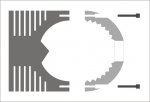- Joined
- Dec 6, 2010
- Messages
- 99
- Points
- 0
I think you can improve you specs, a 90% absorbtion is very low, a flat black surface can do that. Professional beam dumps can have a 99.99% absorbtion. I think yours does much better than 90%, probably above 99%
Yes, probably. I do not have the instruments to check the intensity of the diffuse light returning from the tube, but is very very mild and eye tolerable, i was able to dump a spartan, and while dumped, take off the goggles, without getting any kind of disturb, the room was kinda dark. So, just the beam was visible and a mild diffuse blue, behind the laser on the tripod.







